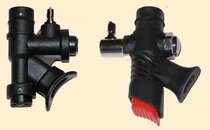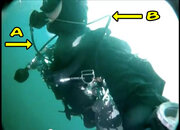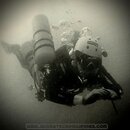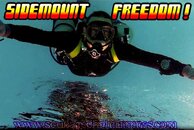I also use the basic reg hose routing concepts that both Lamar and Brian Kakuk show in their videos. Both have the long hose coming off the left behind the head and the shorter hose straight up from the right tank.
I don't really see a benefit to Lamar's approach. The majority of new sidemount divers currently are cross-overs from BM at tech levels. Those people have ingrained skills routing the long-hose from the right hip area and around, with a short hose from the left on bungee. i.e. A typical hogarthian reg set-up. It makes sense to preserve that capability - and there is vast support for it's use, based on pros and cons. I'm not sure why sidemount would change that formula...
I just don't get Andy's disconnect.
It probably stems from a different perception. You're an experienced diver - sufficiently so to improvise and refine your own workable SM rig (as I did). Your (our) experience allows us to problem solve, based upon significant conceptual understanding of the issues involved.
Where we differ is that I teach sidemount. That provides me with experience of a large sample of less experienced divers....and how they adapt to sidemount diving. I see the problems, frustrations and pit-falls that more experienced divers, like you and I, would solve instinctively and without drama.
I see an issue with hose routing from top-mounted LPIs. That's not hypothesis...
I literally see it... in novice sidemount students during training. I see them get snarled up with hoses. I see them bruise their armpits because they can't rotate their tanks forwards without convoluted hoses/clips pinching their soft under-arms. I seem them struggle to access their D-rings, bungees etc..
But you can see the bottom LPI and how the LP hose routes to it.
You can see the clean routing of the reg hoses and the LP hoses and how there is no cluster F.
I can orally inflate the wing.
Agree... but do you think a brand-new sidemount diver could achieve the same? If said diver were also inexperienced in scuba generally?
The agencies are pushing sidemount into the recreational mainstream. The manufacturers picked up that ball and are running with it. Consider OW, OW etc divers moving into sidemount... that is, after all, exactly who these 'blue water/open water/sport' SM BCDs are being sold too...
Just a question on your LPI.... can you fully raise the LPI above your head to dump air in a manner akin to what novice recreational jacket BCD divers might be familiar with?
I believe that is the assumption that potential purchasers of 'sport/OW' SM BCDs will have, based on how they are marketed with the top-LPI. To do so would require an excessively long LP hose (capable of reaching from sidemount reg, to above the divers' head)... hence...
CF bendy hoses.
A minor observation, but your LPI config does cause a slight "morning wood" effect... it's a little 'erect' away from your chest. Shows tension caused by the hose. Maybe a minor issue... but it's one more thing to get snagged on a DSMB line as you pop a bag (not talking about overheads/guidelines either).
One can nit pick if they wish but I looked at the plastic clips Hollis uses to secure their bottom LPI across the chest and I prefer my look. If snagging ever became an issue I could even tuck the LPI under my harness.
The Hollis clip method is an abomination. Every student I had so far took one look at mine (some bungee and a bolt snap) and immediately made the change. Some students opt to run the LPI straight upwards (especially with Hollis, which has a short, stiff corrugated hose). Some run them across the chest, like I do. I find this very intuitive - easy to find and manipulate... very entanglement avoiding..
I don't know about lower training standards - I ain't never had none.
When considering the issues... I also have to consider how students will be taught to deal with those issues. As more recreational divers embrace sidemount, especially at lesser experience levels, you have to assume that the minimum training standards will represent the baseline norm of experience, known skills and conceptual awareness.
Pro's:
It works.
It cost $30 (plus some stuff I had in the workshop).
I have the same opinions of my DIY rig. Except mine cost $100 extra for an OMS Profile adapter.... so I could rule out:
The donut wing tacos up near the shoulders when filled.
I like the Profile also because it does provide some real protection when wriggling in the wrecks. It's covered with gouges and deep scrapes (and rust stains). I think my bladder/wing would have been toast long ago, without it..
Some use of bungee retainers also helps 'shape' the wing... retaining more buoyancy at the bottom, less at the top. That tends to suit sidemount trim very well. A pic of my rig:
![2013-02-04 15.40.37 [].jpg 2013-02-04 15.40.37 [].jpg](https://scubaboard.com/community/data/attachments/94/94027-957af6eb3331c0025bebeb0fe2dc72b4.jpg?hash=lXr26zMxwA)
![2013-02-04 15.40.10 [].jpg 2013-02-04 15.40.10 [].jpg](https://scubaboard.com/community/data/attachments/94/94028-ca657cae0009796a017e9d3b790855a7.jpg?hash=ymV8rgAJeW)
It allows me to work all the operational kinks out of diving SM so when I do buy a rig, I'll know exactly what I want
The one thing mine taught me was that there wasn't any SM rigs out there that were
exactly what I want!

LOL






![2013-02-04 15.40.37 [].jpg 2013-02-04 15.40.37 [].jpg](https://scubaboard.com/community/data/attachments/94/94027-957af6eb3331c0025bebeb0fe2dc72b4.jpg?hash=lXr26zMxwA)
![2013-02-04 15.40.10 [].jpg 2013-02-04 15.40.10 [].jpg](https://scubaboard.com/community/data/attachments/94/94028-ca657cae0009796a017e9d3b790855a7.jpg?hash=ymV8rgAJeW)



